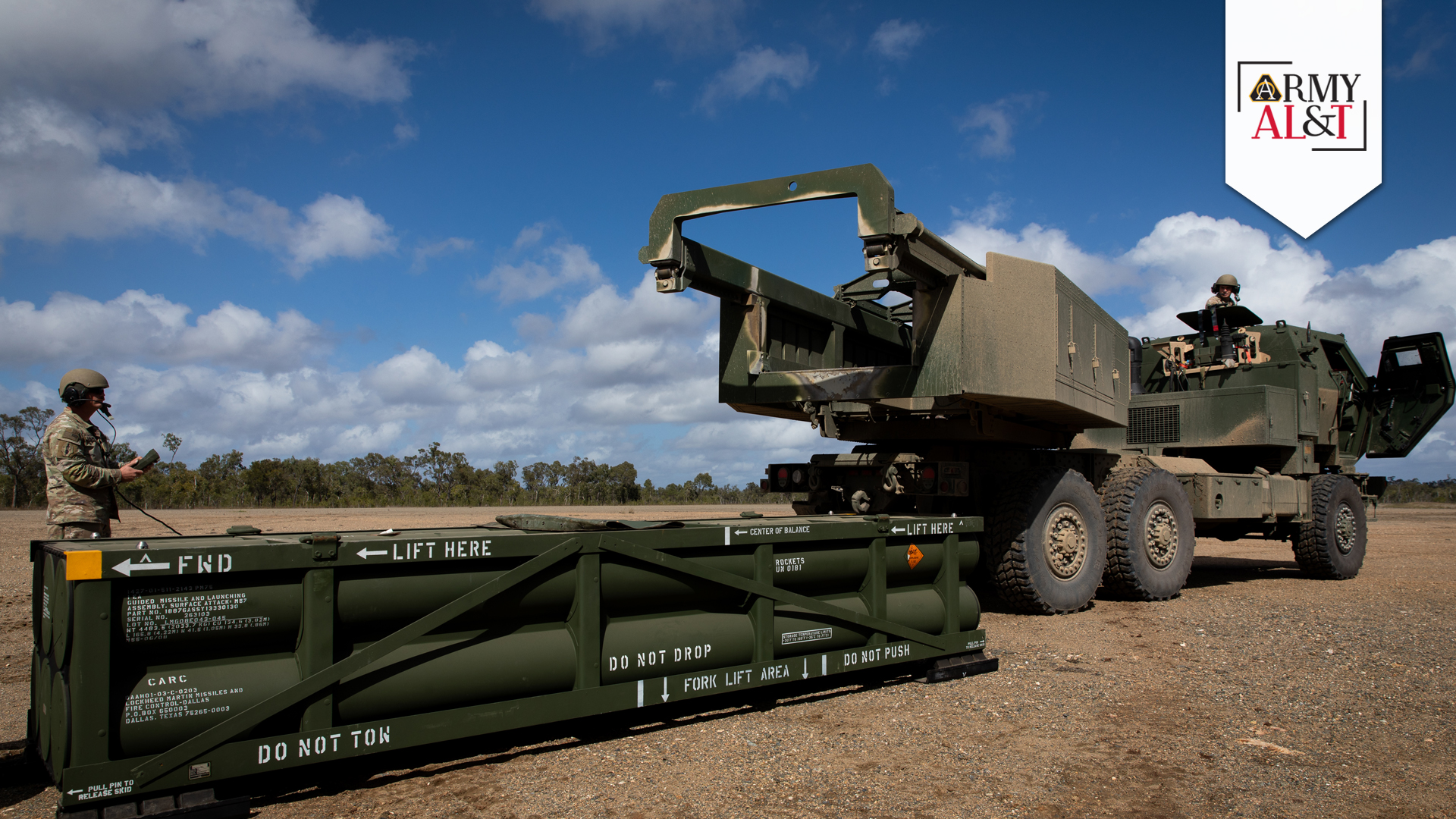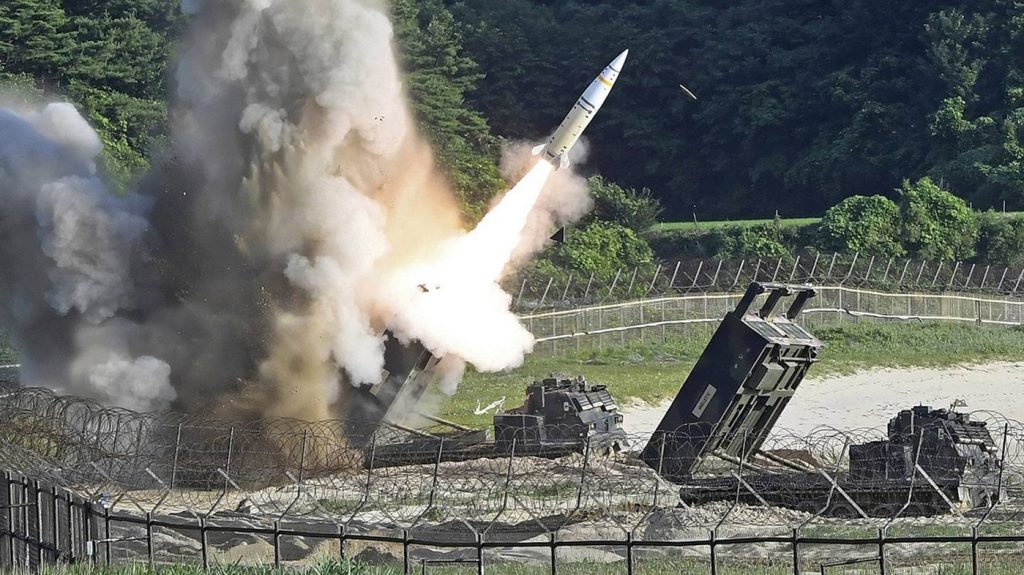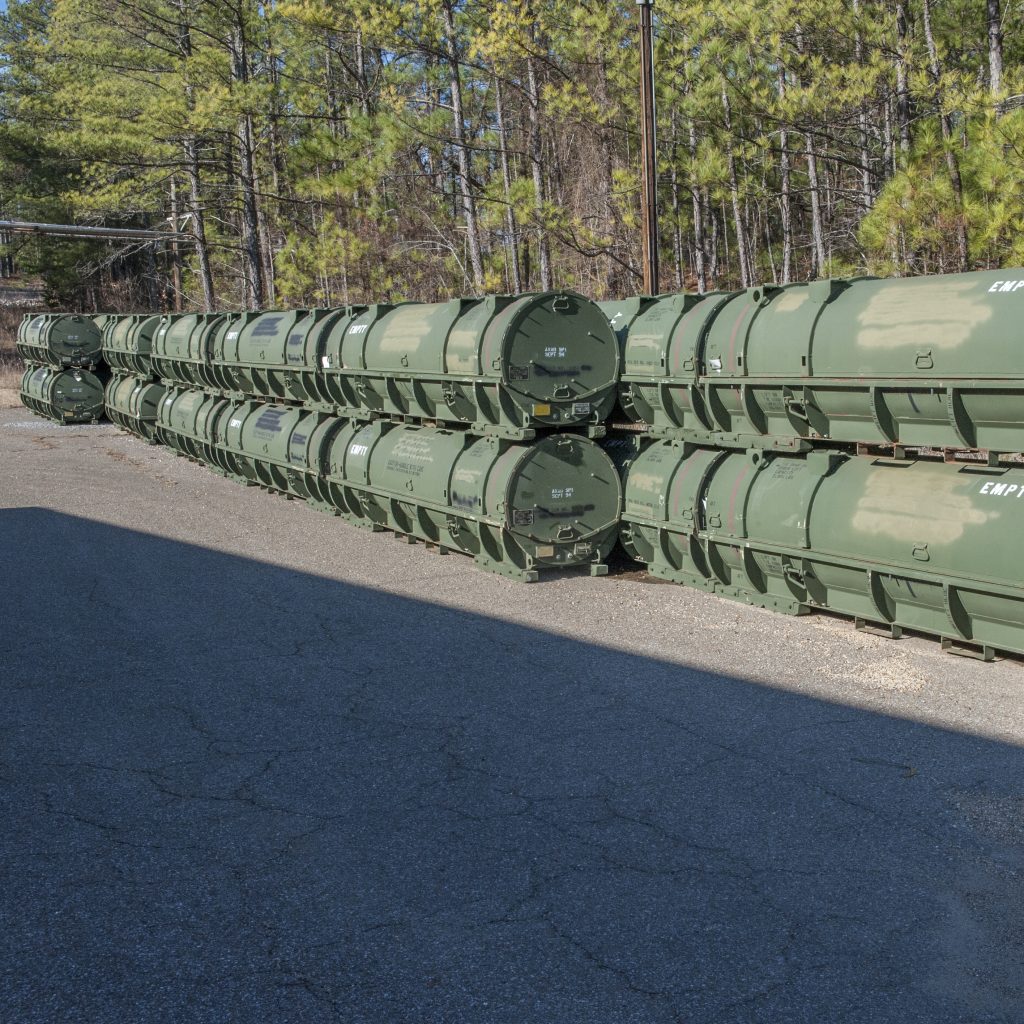
LEVERAGING ATACMS: A U.S. Army Soldier prepares the crane for loading the ATACMS onto HIMARS in support of Talisman Sabre 2023, held in July 2023 at Williamson Airfield in Queensland, Australia. (Photo by Sgt. 1st Class Andrew Dickson, 133rd Mobile Public Affairs Detachment)
As the Precision Strike Missile system replaces the aging Army Tactical Missile System, integrating transformational technology will improve firepower, performance and producibility.
by Cheryl Marino
The Army Tactical Missile System (ATACMS) was first used in response to the strategic demands of Operation Desert Storm in 1991, providing a long-range, precision-guided missile system crucial for striking targets deep within enemy territory. At the time, it was an essential part of the Army’s arsenal for countering threats posed by Iraqi forces.
By the early 2000s, a shift was evident in the Army’s approach toward modernizing missile capabilities. Efforts to provide Soldiers with a more capable and versatile weapon system to meet the challenges of future conflicts led to the development of the Precision Strike Missile (PrSM) in 2020, a next-generation, surface-to-surface missile system was built by Lockheed Martin Corp., aimed at eventually replacing the ATACMS and enhancing the Army’s precision strike capabilities.
At the forefront of this initiative is the Project Manager for Strategic and Operational Rockets and Missiles within the Program Executive Office for Missiles and Space, working alongside the Long-Range Precision Fires Cross-Functional Team.
“The two major differences between the ATACMs and PrSM today are range and loadout quantities,” said Darrell Ames, DOD public affairs officer. Loadout refers to the amount of missiles a launch container, or pod, can hold. “The PrSM has doubled the loadout capability per pod and has a significantly greater range capability.”
While the ATACMS uses pods that contain a single missile with a maximum range of roughly 300 kilometers (approximately 190 miles), PrSM provides two rounds per launch pod, with maximum ranges exceeding 400 kilometers (nearly 250 miles). Both missile systems are compatible with the MLRS M270A2 and HIMARS M-142 family of launchers.
This increase in loadout capacity allows for more munitions to be carried and launched from a single platform without the need for additional pods, or reloads, thereby enhancing the operational flexibility and firepower of the system and enabling more efficient and effective use of the missile system in various combat scenarios. Additionally, PrSM represents a quantum leap in precision strike capabilities. The increased missile range provides greater standoff, which improves crew and launcher survivability.

TIME WILL TELL: The ATACMS, which replaced the Lance Missile System, was first deployed during Operation Desert Storm, but its development origins date back to the Cold War. (Photo courtesy of WSMR)
IF IT AIN’T BROKE
ATACMS was first deployed during Operation Desert Storm, but its development origins actually date back to the Cold War era (1945-1989), when it was developed to counter the former Soviet Union’s arsenal of long-range artillery and missile systems. Though never used by the Army during the Cold War period, its advanced technology made it a highly valuable weapon during Operation Desert Storm, enabling the precision strikes, long-range targeting and significant firepower that were instrumental in the success of the campaign.
Coined “Steel Rain” by Soldiers during Desert Storm, ATACMS replaced the Lance Missile System (1972-1992), a track-mounted system capable of delivering nuclear warheads. It was designed to provide the Army with a versatile weapon system capable of delivering precision strikes against a variety of targets, including enemy air defenses, command and control centers, logistics facilities and troop concentrations. At the time—much like today—there was a significant emphasis on long-range precision strike capabilities to deter aggression and respond effectively in case of conflict.
The need for a system like ATACMS arose from the recognition that traditional artillery systems had limitations in terms of range, accuracy and lethality when it came to striking targets deep within enemy territory. The development of a missile system capable of delivering highly accurate strikes at extended ranges—made possible by advancements in missile technology, guidance systems and propulsion systems—addressed this operational requirement and provided commanders with a new tool for engaging distant and high-value targets.
“The ATACMS missile includes providing the warfighter with an ability to engage both point and area high-value targets with precision fires out to 300 kilometers,” Ames said. “The limitations of ATACMS include range and volume of fire, which are insufficient to meet evolving operational requirements.”
Since entering service with the Army, ATACMS has undergone several upgrades and improvements to enhance its capabilities and maintain its relevance on the modern battlefield. It has seen operational use in various conflicts, including the Persian Gulf War, and in Afghanistan, Iraq and Eastern Europe.

AT FIRST LANCE: Employees for Engineering Research and Consulting Inc., a defense contractor working at Anniston Munitions Center with the Redstone Test Center, prepare a Lance missile for demilitarization. The Lance Missile System was replaced by ATACMS. (Photo by Jennifer Bacchus, Anniston Army Depot)
THIS IS JUST A TEST
PrSM was produced and delivered on an accelerated timeline for the Army’s long-range precision fires priority, but a full transition from ATACMS won’t happen overnight.
Rather than scrapping all ATACMS artillery, the older weapons were carefully assessed and tested while the new PrSM system was being developed and integrated, to determine their continued viability and to ensure that existing assets were used effectively. This allowed for a seamless transition, leveraging the strengths of proven technology while embracing the advancements offered by PrSM to enhance military capabilities.
On Dec. 14, 2021, a stockpile reliability test of early ATACMS versions was conducted by Soldiers from the 3rd Battalion, 321st Field Artillery Regiment, 18th Field Artillery Brigade at the White Sands Missile Range (WSMR) in New Mexico.
According to WSMR Public Affairs, during these tests, older missiles are pulled out of inventory and fired. The shots are then evaluated, and if the missiles can still perform to Army specifications they can inform the Army about the longevity of other missiles in the same stock from the same production run.
“Tests like this make sure that the missile and the launcher communicate, and the software is working properly,” said Mia Fitch, test officer with the WSMR Materiel Test Directorate. By identifying weapons that are still in good working order and able to be deployed, the Army saves money on disposal and replacement of the older missiles and improves readiness by certifying that the weapons could still be used in a future operation.
“[These missiles] are already past their prime, so we need to make sure they are still reliable, they still work, and they have the impact pattern and can reach the distances we need so we can still use them,” Fitch said. Lockheed Martin engineers who supported the test noted that the missiles represented some of the oldest ATACMS missiles still in the Army’s inventory—manufactured over 30 years ago, making them older than most of the Soldiers operating the launcher vehicle.

NO SECOND LANCES: More than half of the Lance missiles stored at the Anniston Munitions Center have been demilitarized using a process performed by the Redstone Test Center and its contract partner, Engineering Research and Consulting Inc. (Photo by Jennifer Bacchus, Anniston Army Depot)
LAUNCHING A STRIKE
Following a development process completed in a compressed timeframe and marked by rigorous research and testing, PrSM has now taken center stage, poised to revolutionize the battlefield. Engineers, scientists and industry partners collaborated closely to refine concepts and address challenges to achieve seamless performance, reliability and compatibility and to ensure PrSM emerged as a formidable successor to ATACMS.
The transition from ATACMS to PrSM is part of the Army’s broader modernization effort aimed at equipping Soldiers with cutting-edge weapon systems to address evolving threats and operational requirements. The PrSM’s advanced features align with the Army’s future operational concepts and strategic priorities, making it a crucial component of force modernization.
“PrSM is … designed to neutralize, suppress and destroy critical and time-sensitive area and point targets at ranges greater than 400 kilometers,” Ames said. “It is a key enabler for the Army’s long-range precision fires modernization priority. It doubles the magazine capacity and extends range by 50 percent,” he said, enabling the Army to engage a wider array of targets while operating from safer distances. The system “aims to provide joint force commanders with an iterative, long-range precision strike capability that facilitates point, moving maritime and relocatable target engagements at ranges exceeding 400 kilometers.”
With improved range, accuracy and lethality compared with ATACMS, PrSM incorporates advanced technologies to improve its performance against various targets and enemy air defenses.
PrSM leverages advancements in missile technology, guidance systems and propulsion to deliver enhanced performance compared to legacy systems like the ATACMS. These technological advancements contribute to improved operational effectiveness and efficiency on the battlefield. “The benefit to the Soldier is derived by increasing the volume of fire at extended ranges,” Ames said.
PrSM’s capabilities are enabled by the Northrop Grumman Corp. rocket motor. According to a Northrop Grumman press release, the motor “incorporates the latest high-performance solid propulsion technologies as well as enhanced Soldier safety features.” Technological advancements, including the potential application of ramjet technology—a variant of airbreathing jet engine that uses the engine’s forward motion to compress incoming air instead of a rotary compressor—could extend the weapon’s range to as much as 1,000 kilometers (roughly 620 miles).
As the PrSM enters service, it will gradually replace the ATACMS in the Army’s inventory. The phased transition allows for the integration of the new missile system into existing force structures while ensuring continuity of mission capabilities and readiness. Delivery will be composed of four increments.
Each increment represents a step forward in enhancing the missile’s capabilities, including range, lethality and technical sophistication, and fulfilling specific objectives. By breaking down the development process this way, the Army can manage risk, optimize resources and ensure a systematic progression toward achieving the desired performance and operational effectiveness for the system.
Ames said initial PrSM prototype flight tests began in 2019, and initial delivery of the first increment of early operational capability missiles began in November 2023, following successful production qualification testing at WSMR.
According to Lockheed Martin, PrSM was designed to achieve the Army’s 400 kilometer-plus requirement and was built with open architecture to ensure new capabilities can be incorporated to achieve longer ranges. “PrSM’s modular design offers an easy path to future growth,” the company stated. That increased capability will provide even greater flexibility to commanders.
In March 2024, Lockheed announced that it had been awarded a fourth production contract from the Army to produce more early operational capacity precision strike missiles. That contract will allow for a significant increase in production capacity to meet Army demand. Additional testing, including an Army-led user test, is planned for later this year.
CONCLUSION
The Army’s transition from the Lance Missile System to ATACMS to PrSM represents more than just a shift in weaponry. It embodies the pursuit of innovation and adaptability in the face of evolving threats and marks a pivotal shift in modern warfare capabilities.
The decision to replace the ATACMS with the PrSM reflects the Army’s commitment to fielding advanced and capable weapon systems that meet the challenges of modern warfare. The PrSM’s performance, extended range, lethality and technological advancements make it a suitable successor to the legacy systems.
With PrSM’s advanced long-range precision fires capabilities, the Army stands ready to meet the challenges of tomorrow’s battlefield with unmatched effectiveness and precision.
For more information, go to https://www.army.mil/peoms.
CHERYL MARINO provides contract support to the U.S. Army Acquisition Support Center (USAASC) at Fort Belvoir, Virginia, as a writer and editor for Army AL&T magazine and Network Runners Inc. Before coming to USAASC, she served as a technical report editor at the U.S. Army Combat Capabilities Development Command Center at Picatinny Arsenal for five years. She holds a B.A. in communications from Seton Hall University and has more than 20 years of writing and editing experience in both the government and private sectors.







